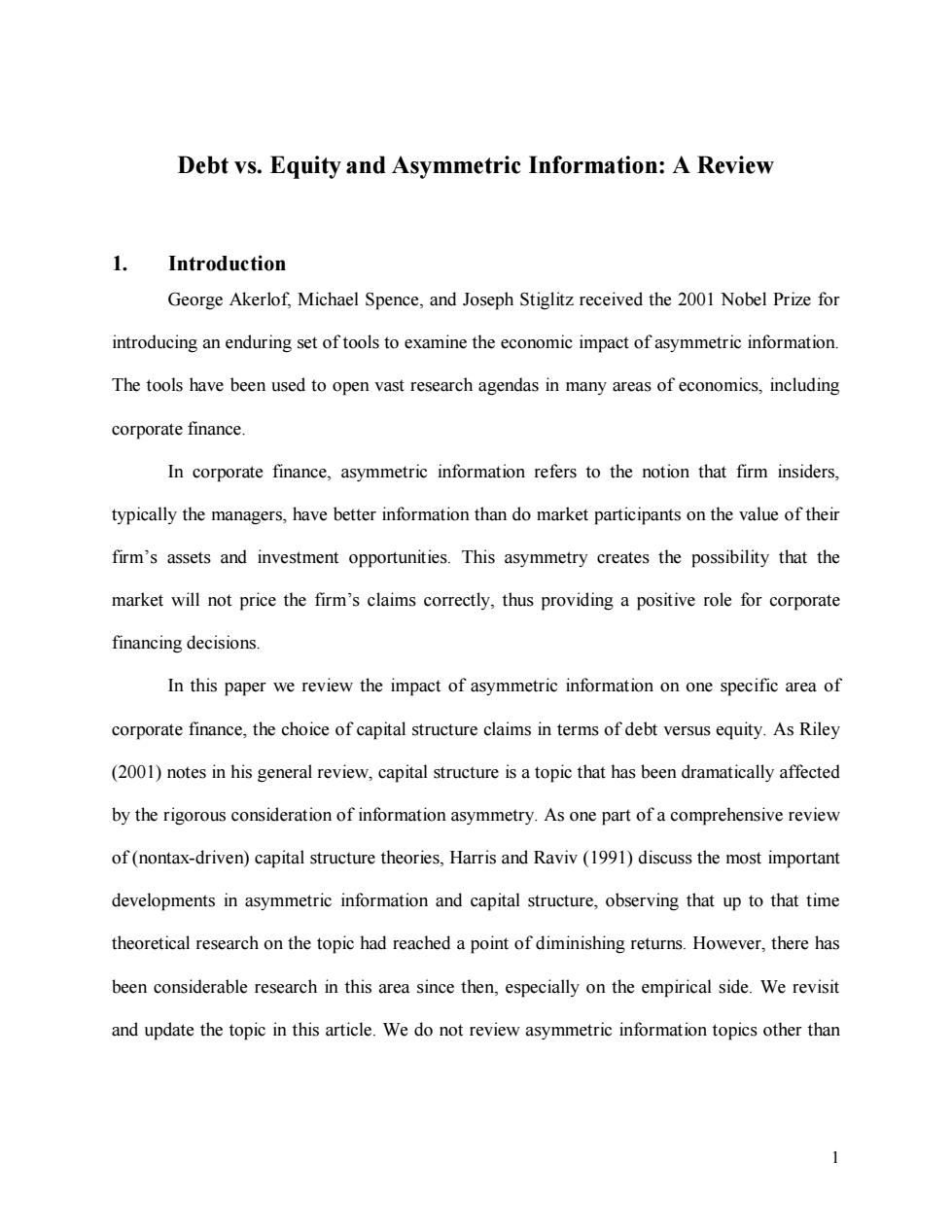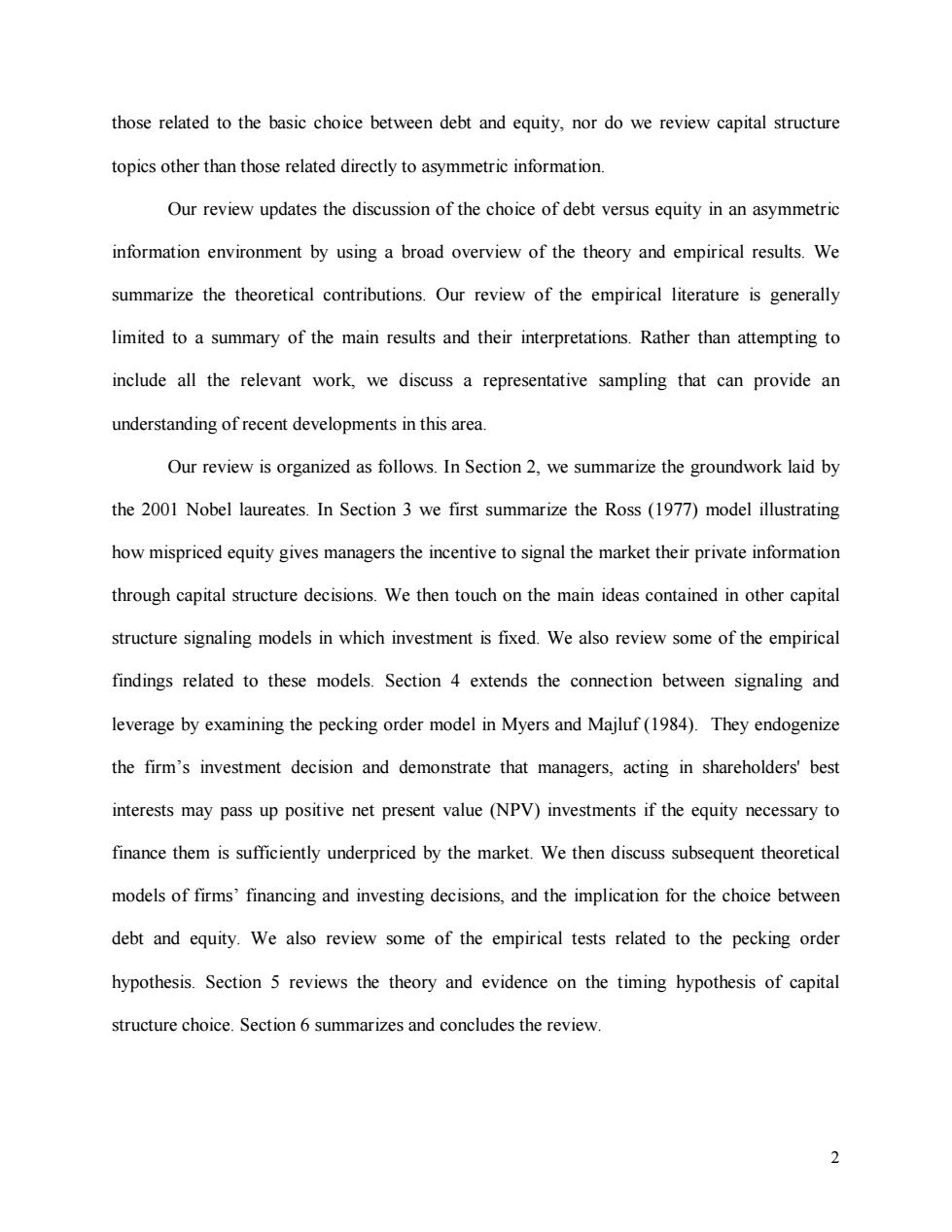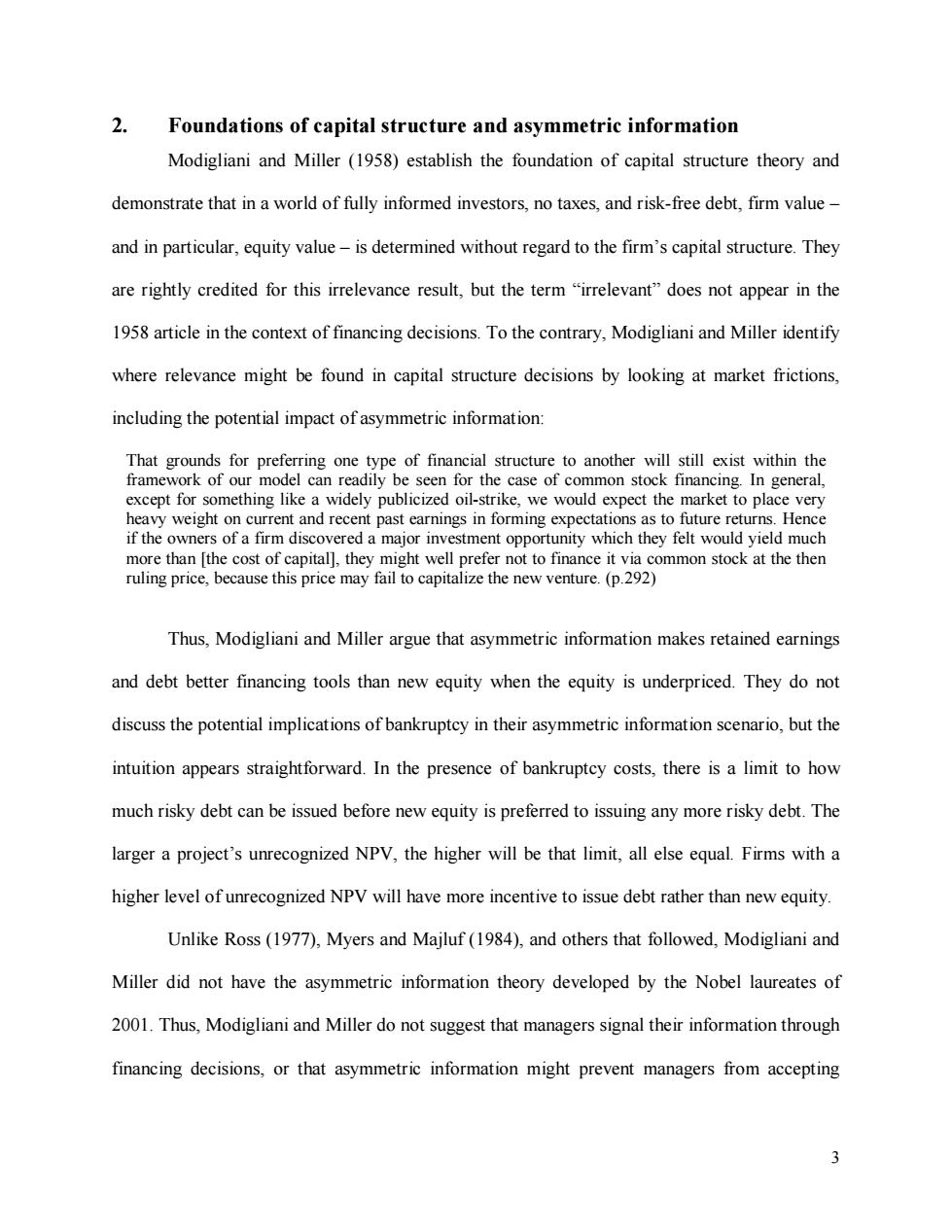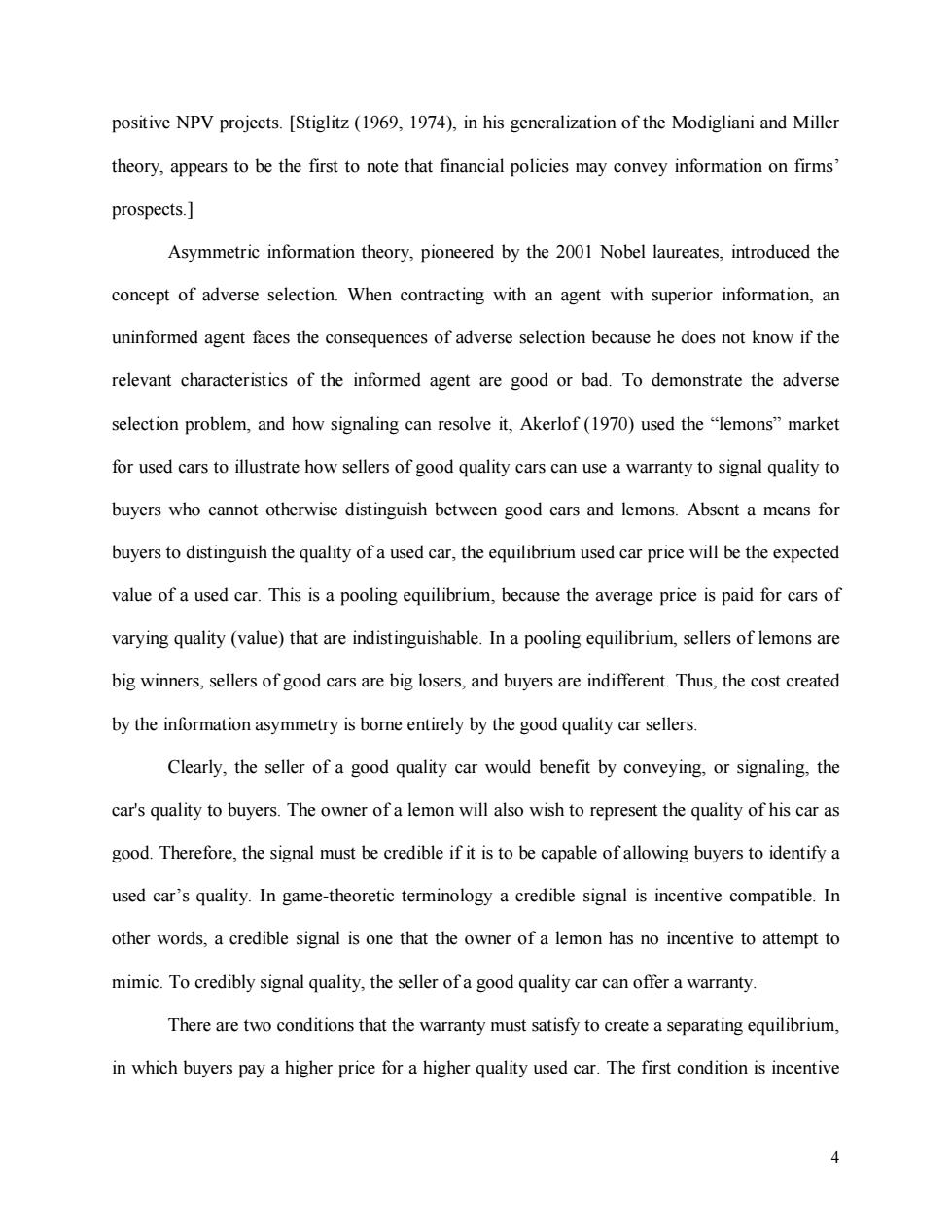
DEBT vs.EQUITY AND ASYMMETRIC INFORMATION: A REVIEW Linda Schmid Klein,University of Connecticut Thomas J.O'Brien*,University of Connecticut Stephen R.Peters,University of Cincinnati March 2002;Forthcoming,The Financial Review *Corresponding author:Department of Finance,University of Connecticut,2100 Hillside Rd.,Storrs,CT 06269-1041;Phone:(860)486-3041;Fax:(860)486-0634;E-mail:thomas.obrien@uconn.edu Acknowledgements:The authors thank Ivan Brick,Shanta Hegde,Tim Manuel (especially),and Steve Wyatt for reading the paper and for insightful comments. Abstract:Recent Nobel Prizes to Akerlof,Spence,and Stiglitz motivate this review of basic concepts and empirical evidence on information asymmetry and the choice of debt vs.equity.We first review the literature that holds investment fixed.Then we review capital structure issues related to the adverse investment selection problem of Myers-Majluf.Finally,we discuss the timing hypothesis of capital structure.Empirical studies do not consistently support one theory of capital structure under information asymmetry over the others.Thus,the review suggests that additional theoretical contributions are needed to help understand and explain findings in the empirical literature. Keywords:capital structure,asymmetric information,pecking order hypothesis,timing hypothesis JEL Classifications:G30/G32
DEBT vs. EQUITY AND ASYMMETRIC INFORMATION: A REVIEW Linda Schmid Klein, University of Connecticut Thomas J. OíBrien*, University of Connecticut Stephen R. Peters, University of Cincinnati March 2002; Forthcoming, The Financial Review *Corresponding author: Department of Finance, University of Connecticut, 2100 Hillside Rd., Storrs, CT 06269-1041; Phone: (860) 486-3041; Fax: (860) 486-0634; E-mail: thomas.obrien@uconn.edu Acknowledgements: The authors thank Ivan Brick, Shanta Hegde, Tim Manuel (especially), and Steve Wyatt for reading the paper and for insightful comments. Abstract: Recent Nobel Prizes to Akerlof, Spence, and Stiglitz motivate this review of basic concepts and empirical evidence on information asymmetry and the choice of debt vs. equity. We first review the literature that holds investment fixed. Then we review capital structure issues related to the adverse investment selection problem of Myers-Majluf. Finally, we discuss the timing hypothesis of capital structure. Empirical studies do not consistently support one theory of capital structure under information asymmetry over the others. Thus, the review suggests that additional theoretical contributions are needed to help understand and explain findings in the empirical literature. Keywords: capital structure, asymmetric information, pecking order hypothesis, timing hypothesis JEL Classifications: G30/G32

Debt vs.Equity and Asymmetric Information:A Review 1. Introduction George Akerlof,Michael Spence,and Joseph Stiglitz received the 2001 Nobel Prize for introducing an enduring set of tools to examine the economic impact of asymmetric information. The tools have been used to open vast research agendas in many areas of economics,including corporate finance. In corporate finance,asymmetric information refers to the notion that firm insiders, typically the managers,have better information than do market participants on the value of their firm's assets and investment opportunities.This asymmetry creates the possibility that the market will not price the firm's claims correctly,thus providing a positive role for corporate financing decisions. In this paper we review the impact of asymmetric information on one specific area of corporate finance,the choice of capital structure claims in terms of debt versus equity.As Riley (2001)notes in his general review,capital structure is a topic that has been dramatically affected by the rigorous consideration of information asymmetry.As one part of a comprehensive review of(nontax-driven)capital structure theories,Harris and Raviv (1991)discuss the most important developments in asymmetric information and capital structure,observing that up to that time theoretical research on the topic had reached a point of diminishing returns.However,there has been considerable research in this area since then,especially on the empirical side.We revisit and update the topic in this article.We do not review asymmetric information topics other than 1
1 Debt vs. Equity and Asymmetric Information: A Review 1. Introduction George Akerlof, Michael Spence, and Joseph Stiglitz received the 2001 Nobel Prize for introducing an enduring set of tools to examine the economic impact of asymmetric information. The tools have been used to open vast research agendas in many areas of economics, including corporate finance. In corporate finance, asymmetric information refers to the notion that firm insiders, typically the managers, have better information than do market participants on the value of their firmís assets and investment opportunities. This asymmetry creates the possibility that the market will not price the firmís claims correctly, thus providing a positive role for corporate financing decisions. In this paper we review the impact of asymmetric information on one specific area of corporate finance, the choice of capital structure claims in terms of debt versus equity. As Riley (2001) notes in his general review, capital structure is a topic that has been dramatically affected by the rigorous consideration of information asymmetry. As one part of a comprehensive review of (nontax-driven) capital structure theories, Harris and Raviv (1991) discuss the most important developments in asymmetric information and capital structure, observing that up to that time theoretical research on the topic had reached a point of diminishing returns. However, there has been considerable research in this area since then, especially on the empirical side. We revisit and update the topic in this article. We do not review asymmetric information topics other than

those related to the basic choice between debt and equity,nor do we review capital structure topics other than those related directly to asymmetric information. Our review updates the discussion of the choice of debt versus equity in an asymmetric information environment by using a broad overview of the theory and empirical results.We summarize the theoretical contributions.Our review of the empirical literature is generally limited to a summary of the main results and their interpretations.Rather than attempting to include all the relevant work,we discuss a representative sampling that can provide an understanding of recent developments in this area. Our review is organized as follows.In Section 2,we summarize the groundwork laid by the 2001 Nobel laureates.In Section 3 we first summarize the Ross(1977)model illustrating how mispriced equity gives managers the incentive to signal the market their private information through capital structure decisions.We then touch on the main ideas contained in other capital structure signaling models in which investment is fixed.We also review some of the empirical findings related to these models.Section 4 extends the connection between signaling and leverage by examining the pecking order model in Myers and Majluf(1984).They endogenize the firm's investment decision and demonstrate that managers,acting in shareholders'best interests may pass up positive net present value (NPV)investments if the equity necessary to finance them is sufficiently underpriced by the market.We then discuss subsequent theoretical models of firms'financing and investing decisions,and the implication for the choice between debt and equity.We also review some of the empirical tests related to the pecking order hypothesis.Section 5 reviews the theory and evidence on the timing hypothesis of capital structure choice.Section 6 summarizes and concludes the review. 2
2 those related to the basic choice between debt and equity, nor do we review capital structure topics other than those related directly to asymmetric information. Our review updates the discussion of the choice of debt versus equity in an asymmetric information environment by using a broad overview of the theory and empirical results. We summarize the theoretical contributions. Our review of the empirical literature is generally limited to a summary of the main results and their interpretations. Rather than attempting to include all the relevant work, we discuss a representative sampling that can provide an understanding of recent developments in this area. Our review is organized as follows. In Section 2, we summarize the groundwork laid by the 2001 Nobel laureates. In Section 3 we first summarize the Ross (1977) model illustrating how mispriced equity gives managers the incentive to signal the market their private information through capital structure decisions. We then touch on the main ideas contained in other capital structure signaling models in which investment is fixed. We also review some of the empirical findings related to these models. Section 4 extends the connection between signaling and leverage by examining the pecking order model in Myers and Majluf (1984). They endogenize the firmís investment decision and demonstrate that managers, acting in shareholders' best interests may pass up positive net present value (NPV) investments if the equity necessary to finance them is sufficiently underpriced by the market. We then discuss subsequent theoretical models of firmsí financing and investing decisions, and the implication for the choice between debt and equity. We also review some of the empirical tests related to the pecking order hypothesis. Section 5 reviews the theory and evidence on the timing hypothesis of capital structure choice. Section 6 summarizes and concludes the review

2. Foundations of capital structure and asymmetric information Modigliani and Miller (1958)establish the foundation of capital structure theory and demonstrate that in a world of fully informed investors,no taxes,and risk-free debt,firm value- and in particular,equity value-is determined without regard to the firm's capital structure.They are rightly credited for this irrelevance result,but the term "irrelevant"does not appear in the 1958 article in the context of financing decisions.To the contrary,Modigliani and Miller identify where relevance might be found in capital structure decisions by looking at market frictions, including the potential impact of asymmetric information: That grounds for preferring one type of financial structure to another will still exist within the framework of our model can readily be seen for the case of common stock financing.In general, except for something like a widely publicized oil-strike,we would expect the market to place very heavy weight on current and recent past earnings in forming expectations as to future returns.Hence if the owners of a firm discovered a major investment opportunity which they felt would yield much more than [the cost of capital],they might well prefer not to finance it via common stock at the then ruling price,because this price may fail to capitalize the new venture.(p.292) Thus,Modigliani and Miller argue that asymmetric information makes retained earnings and debt better financing tools than new equity when the equity is underpriced.They do not discuss the potential implications of bankruptcy in their asymmetric information scenario,but the intuition appears straightforward.In the presence of bankruptcy costs,there is a limit to how much risky debt can be issued before new equity is preferred to issuing any more risky debt.The larger a project's unrecognized NPV,the higher will be that limit,all else equal.Firms with a higher level of unrecognized NPV will have more incentive to issue debt rather than new equity. Unlike Ross (1977),Myers and Majluf(1984),and others that followed,Modigliani and Miller did not have the asymmetric information theory developed by the Nobel laureates of 2001.Thus,Modigliani and Miller do not suggest that managers signal their information through financing decisions,or that asymmetric information might prevent managers from accepting 3
3 2. Foundations of capital structure and asymmetric information Modigliani and Miller (1958) establish the foundation of capital structure theory and demonstrate that in a world of fully informed investors, no taxes, and risk-free debt, firm value ñ and in particular, equity value ñ is determined without regard to the firmís capital structure. They are rightly credited for this irrelevance result, but the term ìirrelevantî does not appear in the 1958 article in the context of financing decisions. To the contrary, Modigliani and Miller identify where relevance might be found in capital structure decisions by looking at market frictions, including the potential impact of asymmetric information: That grounds for preferring one type of financial structure to another will still exist within the framework of our model can readily be seen for the case of common stock financing. In general, except for something like a widely publicized oil-strike, we would expect the market to place very heavy weight on current and recent past earnings in forming expectations as to future returns. Hence if the owners of a firm discovered a major investment opportunity which they felt would yield much more than [the cost of capital], they might well prefer not to finance it via common stock at the then ruling price, because this price may fail to capitalize the new venture. (p.292) Thus, Modigliani and Miller argue that asymmetric information makes retained earnings and debt better financing tools than new equity when the equity is underpriced. They do not discuss the potential implications of bankruptcy in their asymmetric information scenario, but the intuition appears straightforward. In the presence of bankruptcy costs, there is a limit to how much risky debt can be issued before new equity is preferred to issuing any more risky debt. The larger a projectís unrecognized NPV, the higher will be that limit, all else equal. Firms with a higher level of unrecognized NPV will have more incentive to issue debt rather than new equity. Unlike Ross (1977), Myers and Majluf (1984), and others that followed, Modigliani and Miller did not have the asymmetric information theory developed by the Nobel laureates of 2001. Thus, Modigliani and Miller do not suggest that managers signal their information through financing decisions, or that asymmetric information might prevent managers from accepting

positive NPV projects.[Stiglitz (1969,1974),in his generalization of the Modigliani and Miller theory,appears to be the first to note that financial policies may convey information on firms' prospects.] Asymmetric information theory,pioneered by the 2001 Nobel laureates,introduced the concept of adverse selection.When contracting with an agent with superior information,an uninformed agent faces the consequences of adverse selection because he does not know if the relevant characteristics of the informed agent are good or bad.To demonstrate the adverse selection problem,and how signaling can resolve it,Akerlof(1970)used the "lemons"market for used cars to illustrate how sellers of good quality cars can use a warranty to signal quality to buyers who cannot otherwise distinguish between good cars and lemons.Absent a means for buyers to distinguish the quality of a used car,the equilibrium used car price will be the expected value of a used car.This is a pooling equilibrium,because the average price is paid for cars of varying quality (value)that are indistinguishable.In a pooling equilibrium,sellers of lemons are big winners,sellers of good cars are big losers,and buyers are indifferent.Thus,the cost created by the information asymmetry is borne entirely by the good quality car sellers. Clearly,the seller of a good quality car would benefit by conveying,or signaling,the car's quality to buyers.The owner of a lemon will also wish to represent the quality of his car as good.Therefore,the signal must be credible if it is to be capable of allowing buyers to identify a used car's quality.In game-theoretic terminology a credible signal is incentive compatible.In other words,a credible signal is one that the owner of a lemon has no incentive to attempt to mimic.To credibly signal quality,the seller of a good quality car can offer a warranty. There are two conditions that the warranty must satisfy to create a separating equilibrium, in which buyers pay a higher price for a higher quality used car.The first condition is incentive 4
4 positive NPV projects. [Stiglitz (1969, 1974), in his generalization of the Modigliani and Miller theory, appears to be the first to note that financial policies may convey information on firmsí prospects.] Asymmetric information theory, pioneered by the 2001 Nobel laureates, introduced the concept of adverse selection. When contracting with an agent with superior information, an uninformed agent faces the consequences of adverse selection because he does not know if the relevant characteristics of the informed agent are good or bad. To demonstrate the adverse selection problem, and how signaling can resolve it, Akerlof (1970) used the ìlemonsî market for used cars to illustrate how sellers of good quality cars can use a warranty to signal quality to buyers who cannot otherwise distinguish between good cars and lemons. Absent a means for buyers to distinguish the quality of a used car, the equilibrium used car price will be the expected value of a used car. This is a pooling equilibrium, because the average price is paid for cars of varying quality (value) that are indistinguishable. In a pooling equilibrium, sellers of lemons are big winners, sellers of good cars are big losers, and buyers are indifferent. Thus, the cost created by the information asymmetry is borne entirely by the good quality car sellers. Clearly, the seller of a good quality car would benefit by conveying, or signaling, the car's quality to buyers. The owner of a lemon will also wish to represent the quality of his car as good. Therefore, the signal must be credible if it is to be capable of allowing buyers to identify a used carís quality. In game-theoretic terminology a credible signal is incentive compatible. In other words, a credible signal is one that the owner of a lemon has no incentive to attempt to mimic. To credibly signal quality, the seller of a good quality car can offer a warranty. There are two conditions that the warranty must satisfy to create a separating equilibrium, in which buyers pay a higher price for a higher quality used car. The first condition is incentive